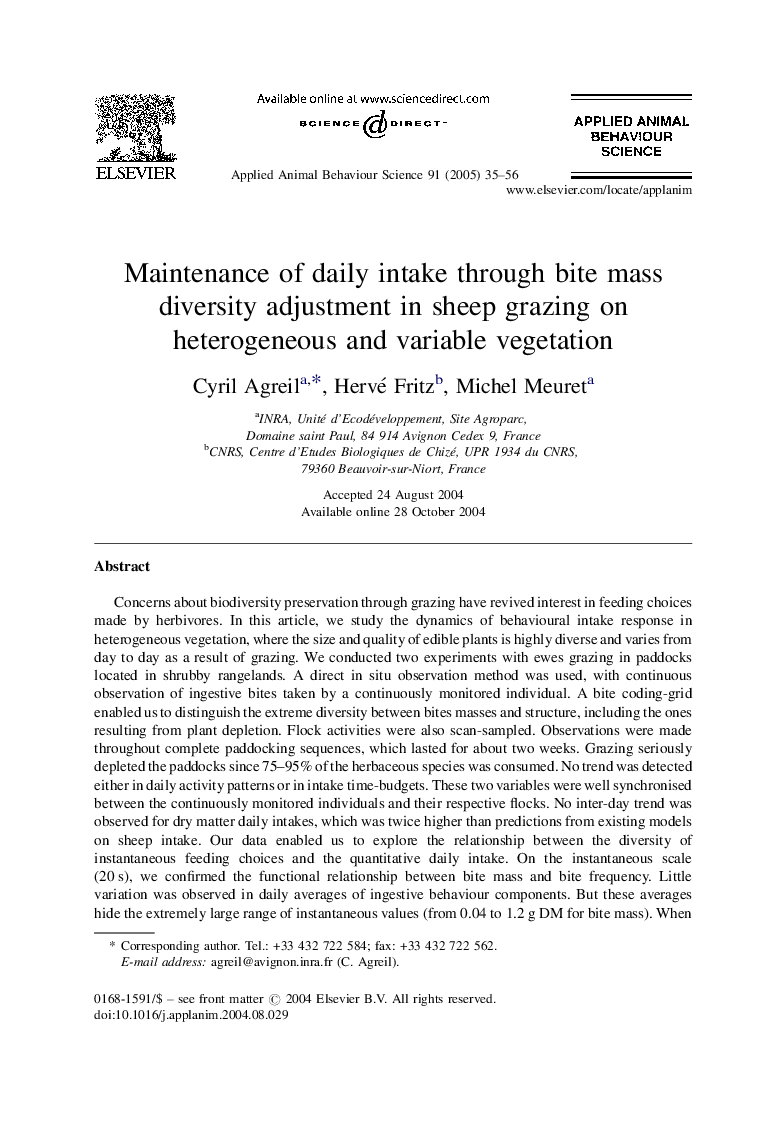| کد مقاله | کد نشریه | سال انتشار | مقاله انگلیسی | نسخه تمام متن |
|---|---|---|---|---|
| 9475842 | 1625458 | 2005 | 22 صفحه PDF | دانلود رایگان |
عنوان انگلیسی مقاله ISI
Maintenance of daily intake through bite mass diversity adjustment in sheep grazing on heterogeneous and variable vegetation
دانلود مقاله + سفارش ترجمه
دانلود مقاله ISI انگلیسی
رایگان برای ایرانیان
کلمات کلیدی
موضوعات مرتبط
علوم زیستی و بیوفناوری
علوم کشاورزی و بیولوژیک
علوم دامی و جانورشناسی
پیش نمایش صفحه اول مقاله

چکیده انگلیسی
Concerns about biodiversity preservation through grazing have revived interest in feeding choices made by herbivores. In this article, we study the dynamics of behavioural intake response in heterogeneous vegetation, where the size and quality of edible plants is highly diverse and varies from day to day as a result of grazing. We conducted two experiments with ewes grazing in paddocks located in shrubby rangelands. A direct in situ observation method was used, with continuous observation of ingestive bites taken by a continuously monitored individual. A bite coding-grid enabled us to distinguish the extreme diversity between bites masses and structure, including the ones resulting from plant depletion. Flock activities were also scan-sampled. Observations were made throughout complete paddocking sequences, which lasted for about two weeks. Grazing seriously depleted the paddocks since 75-95% of the herbaceous species was consumed. No trend was detected either in daily activity patterns or in intake time-budgets. These two variables were well synchronised between the continuously monitored individuals and their respective flocks. No inter-day trend was observed for dry matter daily intakes, which was twice higher than predictions from existing models on sheep intake. Our data enabled us to explore the relationship between the diversity of instantaneous feeding choices and the quantitative daily intake. On the instantaneous scale (20Â s), we confirmed the functional relationship between bite mass and bite frequency. Little variation was observed in daily averages of ingestive behaviour components. But these averages hide the extremely large range of instantaneous values (from 0.04 to 1.2Â g DM for bite mass). When vegetation size and structure declined as a result of grazing, the ewes progressively took larger bite masses with equivalent nutritive quality, thus adopting a pattern of consumption that is not consistent with the general assumption that such bites are chosen during the first day, as a result of the behavioural quantity-quality trade-off. This article provides knowledge about which type of diversity in plant parts size, structure and composition offers a small ruminant satisfying behavioural leeway in composing its meals and reaching physical satiety. We tend to discard pastoral management practices focused on biomass evaluation, and encourage further studies that will help qualify the nature and structure of vegetation that offers adjustment possibilities at both the individual and flock levels.
ناشر
Database: Elsevier - ScienceDirect (ساینس دایرکت)
Journal: Applied Animal Behaviour Science - Volume 91, Issues 1â2, May 2005, Pages 35-56
Journal: Applied Animal Behaviour Science - Volume 91, Issues 1â2, May 2005, Pages 35-56
نویسندگان
Cyril Agreil, Hervé Fritz, Michel Meuret,